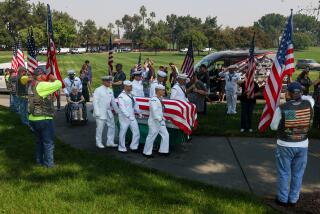Lloyd Bucher, 76; Captain of Ship Seized by N. Korea
- Share via
Retired Navy Cmdr. Lloyd “Pete” Bucher, who was the captain of the intelligence-gathering ship Pueblo when it was captured off North Korea in 1968 and its crew held in brutal captivity for 11 months, died Wednesday at a nursing home in the San Diego suburb of Poway after years of declining health. He was 76.
Bucher was severely criticized by a Naval Court of Inquiry for surrendering his ship without firing a shot, but many of the 82 crew members credited his bravery and stoic example with helping them survive merciless beatings and torture in a North Korean prison camp.
“The man was a giant,” said Stu Russell, a Pueblo crew member and president of the USS Pueblo Veterans Assn. “I don’t know where he got the strength and courage to go through what he did.”
Quiet, almost diffident, Bucher was an orphan who was reared at Boys Town, the fabled facility for homeless boys in Nebraska, and served two years in the Navy before attending the University of Nebraska. He was commissioned in 1953 and began a slow but steady rise through the naval ranks.
In international waters off North Korea the night of Jan. 23, 1968, with little time to ponder options, Bucher faced the classic dilemma of military leadership: whether to put the mission ahead of the men, whether to consign men to die in a hopeless cause.
Convinced that the North Koreans were bent on a massacre, Bucher chose to surrender his ship to save his sailors’ lives. In the process he became one of the most controversial figures in U.S. military history.
The Pueblo, an aging, lightly armed vessel ordered to watch the movement of foreign ships and conduct electronic snooping on the volatile North Korean regime, was his first command.
As six North Korean ships racked the Pueblo with 15 heavy shells and an estimated 2,200 smaller rounds, one sailor was killed and several were wounded. Bucher ordered sailors to burn and destroy secret documents and equipment and send an SOS to other U.S. ships.
No help was dispatched, although a carrier task force was in the region. “The U.S. at that time had enormous military forces in the western Pacific, within five minutes of flying time of us,” Bucher said in a 1988 interview. “I would have thought something could have been mustered to come to our aid.”
The America of 1968, of course, was different from that of today, and the difference is apparent in the reaction of the public and Navy to the seizure and later release of the Pueblo crew.
Captured Americans were not lionized and considered heroes, as they are today; in fact, many observers have said the military seemed to treat former prisoners as if they carried a stigma.
Even when Congress voted to establish a POW citation, the Pentagon initially argued that the Pueblo sailors were detainees, not POWs, and thus not eligible. The sailors finally got their POW medals in 1989.
“There were so many people at the Joint Chiefs of Staff level on down who weren’t paying attention to their damn job,” Bucher said. “They would have greatly preferred for the North Koreans to have done us in completely.”
Although the Navy opted not to court-martial him, the criticism from his peers was withering. After being hospitalized for his injuries, Bucher returned to active duty, including involvement in the mining of Haiphong Harbor in North Vietnam. He retired in 1973.
The specter of a U.S. warship seized without firing a shot was humiliating for the Navy.
“The story of the Pueblo, in a nutshell, is one of a naval officer, his crew and his ship, set to do a thing; things went bad, and the Navy abandoned them,” Bucher wrote in a letter published in 1989 in two widely read naval magazines.
The letter set loose an immediate salvo.
“He never manned the guns,” wrote retired Adm. John J. Hyland, former commander in chief of the Pacific Fleet, who had convened the Court of Inquiry. “He didn’t go to general quarters until he’d already been fired upon.... Bucher got a completely failing grade.”
The passage of time has done little to soften the view of many in the Navy.
“He had other options,” said a retired Navy ship captain Thursday when asked to comment on Bucher. “He could have gone down fighting.”
Wounded in the capture, Bucher was singled out for punishment and was brutalized into signing an oddly worded “confession.” In a picture taken by the Koreans, Pueblo crew members can be seen using a finger gesture to display their defiance.
Bucher wrote a book, “My Story,” published in 1971. In retirement, he lived in Poway, painting seascapes and tending his garden. He gave innumerable interviews, kept a listed phone number and answered all questions in a gentle, thoughtful manner.
Bucher also lectured at colleges and conventions. Although he was tough in his criticism of the Navy, he stressed themes of patriotism and thankfulness for the opportunities America offers. He promoted the Navy as a great career for young people.
Although regarded by many as a victim of the Navy’s lack of planning in case one of its ships was challenged by the North Koreans, Bucher suffered occasional indignities. When he was set to ride in a veterans parade in San Diego, a group of retired officers protested his appearance, which did go on.
“What do they want me to do?” Bucher asked when told of the protest. “I did what I thought was best. I can’t change history.”
Bucher is survived by his wife, Rose, and sons Mark and Michael.
A funeral is scheduled for Tuesday at Ft. Rosecrans National Cemetery in San Diego.
*
On the Web -- To read Times staff writer Richard E. Meyer’s in-depth 1990 profile of Bucher and the Pueblo incident, go to latimes.com/bucher.
More to Read
Sign up for Essential California
The most important California stories and recommendations in your inbox every morning.
You may occasionally receive promotional content from the Los Angeles Times.










